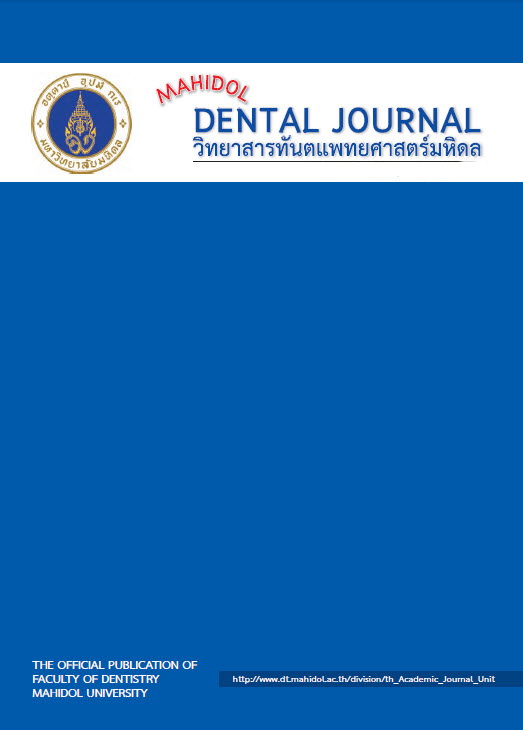Comparison of Microleakage between Resin-based and Bioceramic-based Root Canal Sealers by Fluid Filtration Technique
Main Article Content
Abstract
Objectives: The aim of this study was to compare the microleakage between resin-based (AH plus®) and bioceramic-based (EndoSequence BC Sealer®) root canal sealers using the fluid filtration technique.
Materials and methods: Seventy extracted human mandibular premolars resected 12 mm. from the apex were instrumented to size 50/.04 using the Mtwo rotary system. They were then randomly divided into 3 experimental groups based on obturation technique and sealer (G1: AH plus obturated by warm vertical compaction, G2: EndoSequence BC Sealer obturated by warm vertical compaction, and G3: EndoSequence BC Sealer obturated by single cone technique), and 2 control groups. After their completed obturations, the samples were stored in containers of 100 percent relative humidity for 48 hours. Microleakage was assessed using fluid filtration method, employing a pressure equivalent to 0.03 atm through a 1-mm diameter capillary tube. Statistical analysis was performed using the Kruskal-Wallis test followed by Dunn’s multiple comparison test at the 0.05 significance level.
Results: The rate of fluid leakage between the two EndoSequence BC Sealer groups (EndoSequence BC Sealer by single cone technique and EndoSequence BC Sealer by warm vertical compaction) were significantly different (p < 0.05). However, no statistically significant difference was found between the AH plus group and both the EndoSequence BC Sealer groups.
Article Details
References
2. Ng YL, Mann V, Rahbaran S, Lewsey J, Gulabivala K. Outcome of primary root canal treatment: systematic review of the literature – Part 2. Influence of clinical factors. Int Endod J 2008;41(1):6-31.
3. Hommez GM, Coppens CR, De Moor RJ. Periapical health related to the quality of coronal restorations and root fillings. Int Endod J 2002; 35(8): 680–9.
4. Siqueira JF Jr, Rôças IN, Alves FR, Campos LC. Periradicular status related to the quality of coronal restorations and root canal fillings in a Brazilian population. Oral Surg, Oral Med Oral Pathol Oral Radiol Endod 2005; 100(3): 369–74.
5. Ørstavik D, Nordahl I, Tibballs JE. Dimensional change following setting of root canal sealer materials. Dent Mater 2001; 17(6): 512–9.
6. Schafer E, Zandbiglari T. Solubility of root-canal sealers in water and artificial saliva. Int Endod J 2003; 36(10): 660–9.
7. Zhou HM, Shen Y, Zheng W, Li L, Zheng YF, Haapasalo M. Physical properties of 5 root canal sealers. J Endod 2013; 39(10): 1281–6.
8. Jeong JW, DeGraft-Johnson A, Dorn SO, Di Fiore PM. Dentinal tubule penetration of a calcium silicate-based root canal sealer with different obturation methods. J Endod 2017; 43(4): 633–7.
9. McMichael GE, Primus CM, Opperman LA. Dentinal tubule penetration of tricalcium silicate sealers. J Endod 2016; 42(4): 632–6.
10. Kuçi A, Alaçam T, Yavaş Ö, Ergul-Ulger Z, Kayaoglu G. Sealer penetration into dentinal tubules in the presence or absence of smear layer: A confocal laser scanning microscopic study. J Endod 2014; 40(10): 1627–31.
11. ORSTAVIK D. Materials used for root canal obturation: technical, biological and clinical testing. Endod Top 2005; 12(1): 25–38.
12. AL-Haddad A, Che Ab Aziz ZA. Bioceramic-based root canal sealers: a review. Int J Biomater 2016; Article ID 9753210.
13. Okiji T, Yoshiba K. Reparative dentinogenesis induced by mineral trioxide aggregate: A review from the biological and physicochemical points of view. Int J Dent 2009; Article ID 464280.
14. Gomes-Cornélio AL, Rodrigues EM, Salles LP, Mestieri LB, Faria G, Guerreiro-Tanomaru JM, et al. Bioactivity of MTA Plus, Biodentine and an experimental calcium silicate-based cement on human osteoblast-like cells. Int Endod J 2017; 50(1): 39–47.
15. Zhang W, Li Z, Peng B. Assessment of a new root canal sealer’s apical sealing ability. Oral Surg, Oral Med Oral Pathol Oral Radiol Endod 2009; 107(6): e79–82.
16. Silva Almeida LH, Moraes RR, Morgental RD, Pappen FG. Are premixed calcium silicate-based endodontic sealers comparable to conventional materials? A systematic review of in vitro studies. J Endod 2017; 43(4): 527–35.
17. WU M-K, GEE AJ, WESSELINK PR. Fluid transport and dye penetration along root canal fillings. Int Endod J 1994; 27(5): 233–8.
18. Jafari F, Jafari S. Composition and physicochemical properties of calcium silicate based sealers: A review article. J Clin Exp Dent 2017; 9(10): e1249–55.
19. Candeiro GT, Correia FC, Duarte MA, Ribeiro-Siqueira DC, Gavini G. Evaluation of radiopacity, pH, release of calcium Ions, and flow of a bioceramic root canal sealer. J Endod 2012; 38(6): 842–5.
20. Xuereb M, Vella P, Damidot D, Sammut C V, Camilleri J. In Situ assessment of the setting of tricalcium silicate-based sealers using a dentin pressure model. J Endod 2015; 41(1): 111–24.
21. Kim H, Kim E, Lee S-J, Shin S-J. Comparisons of the retreatment efficacy of calcium silicate and epoxy resin-based sealers and residual sealer in dentinal tubules. J Endod 2015; 41(12): 2025–30.
22. Hess D, Solomon E, Spears R, He J. Retreatability of a bioceramic root canal sealing material. J Endod 2011; 37(11): 1547–9.
23. Pommel L, Camps J. Effects of pressure and measurement time on the fluid filtration method in endodontics. J Endod 2001; 27(4): 256–8.
24. Robberecht L, Colard T, Claisse-Crinquette A. Qualitative evaluation of two endodontic obturation techniques: tapered single-cone method versus warm vertical condensation and injection system: An in vitro study. J Oral Sci 2012; 54(1): 99–104.
25. Capar ID, Saygili G, Ergun H, Gok T, Arslan H, Ertas H. Effects of root canal preparation, various filling techniques and retreatment after filling on vertical root fracture and crack formation. Dent Traumatol 2015; 31(4): 302–7.


